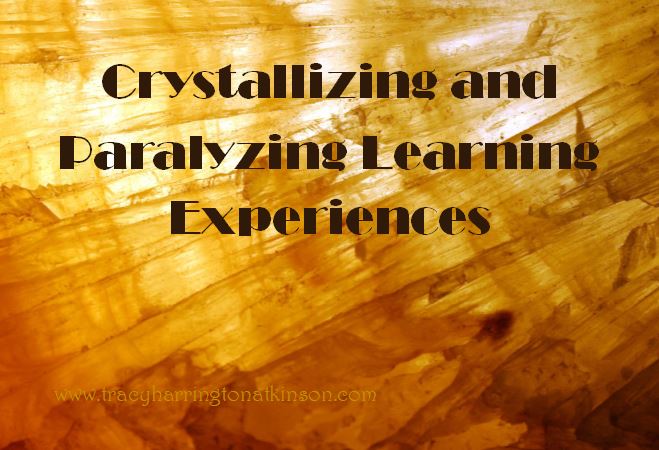Crystallizing versus Paralyzing Learning Experiences
Crystallizing versus paralyzing experiences were first discovered by David Feldman and later expounded upon by Howard Gardner who identified these experiences as “turning points” (Walters & Gardner, 1986) in the development of the intelligences related to the multiple intelligences theory. These experiences generally occur during childhood but can spread outwards into the rest of life.
Paralyzing Experiences
Paralyzing experiences are associated with shutting off an intelligence or shutting down an interest. These experiences are prevalent in the current structure of technology and women in the field. Ashcraft, Eager & Friend (2012) associated with NCWIT (National Center for Women and Information Technology) compiled a report enumerating the instructional methodologies which lead to paralyzing experiences, distracting women from pursuing field within technology. These strategies include “1) curriculum that is irrelevant, 2) pedagogies that discourage collaboration, 3) lack of opportunities to take risks and make mistakes, and 4) heavy reliance on lecturing instead of active, hands-on, project-based learning” (p18).
Paralyzing experiences are those associated with shame, guilt, fear, anger and other negative emotions which hinder growth (Miller, 1981).
Crystallizing Experiences
Crystallizing experiences are those experiences which promote and encourage learning. These experiences spark an interest in learning. They promote interest in a topic and drive further learning opportunities. Knowles (…) called this kind of learning experience a warm learning environment. Such a warm learning climate possesses mutual respect for individual experience and creativity shaping a “warm, mutually respectful, dialogic and mutually trustful” (p. 29) environment. It is conducive to communication where participants may be actively involved.
Anne Sullivan demonstrated the ability to mold crystallizing experiences for young Helen Keller. Helen relates:
A day or two afterward I was stringing beads of different sizes in symmetrical groups—two large beads, three small ones, and so on. I had made many mistakes, and Miss Sullivan had pointed them out again and again with gentle patience. Finally, I noticed a very obvious error in the sequence and for an
instant I concentrated my attention on the lesson and tried to think how I should have arranged the beads. Miss Sullivan touched my forehead and spelled with decided emphasis, “Think.” In a flash, I knew that the word was the name of the process that was going on in my head. This was my first conscious perception of an abstract idea (Keller,1995).
Environmental Influences
Armstrong lists five environmental factors which will with promote or stifle the development of multiple intelligences.
- Access to resources or mentors
- Historical-cultural factors
- Geographic factors
- Familial factors
- Situational factors
The challenge as educators, individuals and parents is to continually promote learning experiences, encourage learners and be self-aware as to not distract, detour or discourage learning whether intentionally or unconsciously.
Sources:
Armstrong, T. (2009). Multiple Intelligences in the Classroom. ASCD: Alexandria, Virginia.
Ashcraft, C., Eager, E. & Friend, M. (2012). Girls in It: The Facts. NCWIT. Retrieved from https://www.ncwit.org/sites/default/files/resources/girlsinit_thefacts_fullreport2012.pdf
Keller, H. (1995). The Story of my Life. Dover Publications: New York, New York.
Knowles, M. (1975). Self-directed learning: a guide for learners and teachers. Parsippany, New Jersey: Globe Fearon Press.
Miller, A. (1981). The Drama of the Gifted Child. Basic Books: New York, New York.
Walters, J., & Gardner, H. (1986). The theory of multiple intelligences: Some issues and answers. In R. Sternberg & R. Wagner (Eds.), Practical intelligence: Origins of competence in the everyday world (pp. 163-182). New York: Cambridge University Press.
By Tracy Atkinson
 Tracy Atkinson, mother of six, lives in the Midwest with her husband and spirited long-haired miniature dachshunds. She is a teacher, having taught elementary school to higher education, holding degrees in elementary education and a master’s in higher education. Her passion is researching, studying and investigating the attributes related to self-directed learners and learning styles. She has published several titles, including MBTI Learning Styles: A Practical Approach, The Art of Learning Journals, Calais: The Annals of the Hidden, Lemosa: The Annals of the Hidden, Book Two, Rachel’s 8, The Personal Pursuit of Perfection and Securing Your Tent. She is currently working on a non-fiction text exploring the attributes of self-directed learners: The Five Characteristics of Self-directed Learners.
Tracy Atkinson, mother of six, lives in the Midwest with her husband and spirited long-haired miniature dachshunds. She is a teacher, having taught elementary school to higher education, holding degrees in elementary education and a master’s in higher education. Her passion is researching, studying and investigating the attributes related to self-directed learners and learning styles. She has published several titles, including MBTI Learning Styles: A Practical Approach, The Art of Learning Journals, Calais: The Annals of the Hidden, Lemosa: The Annals of the Hidden, Book Two, Rachel’s 8, The Personal Pursuit of Perfection and Securing Your Tent. She is currently working on a non-fiction text exploring the attributes of self-directed learners: The Five Characteristics of Self-directed Learners.
Check out the online courses at: Student Success Space


Comments are closed